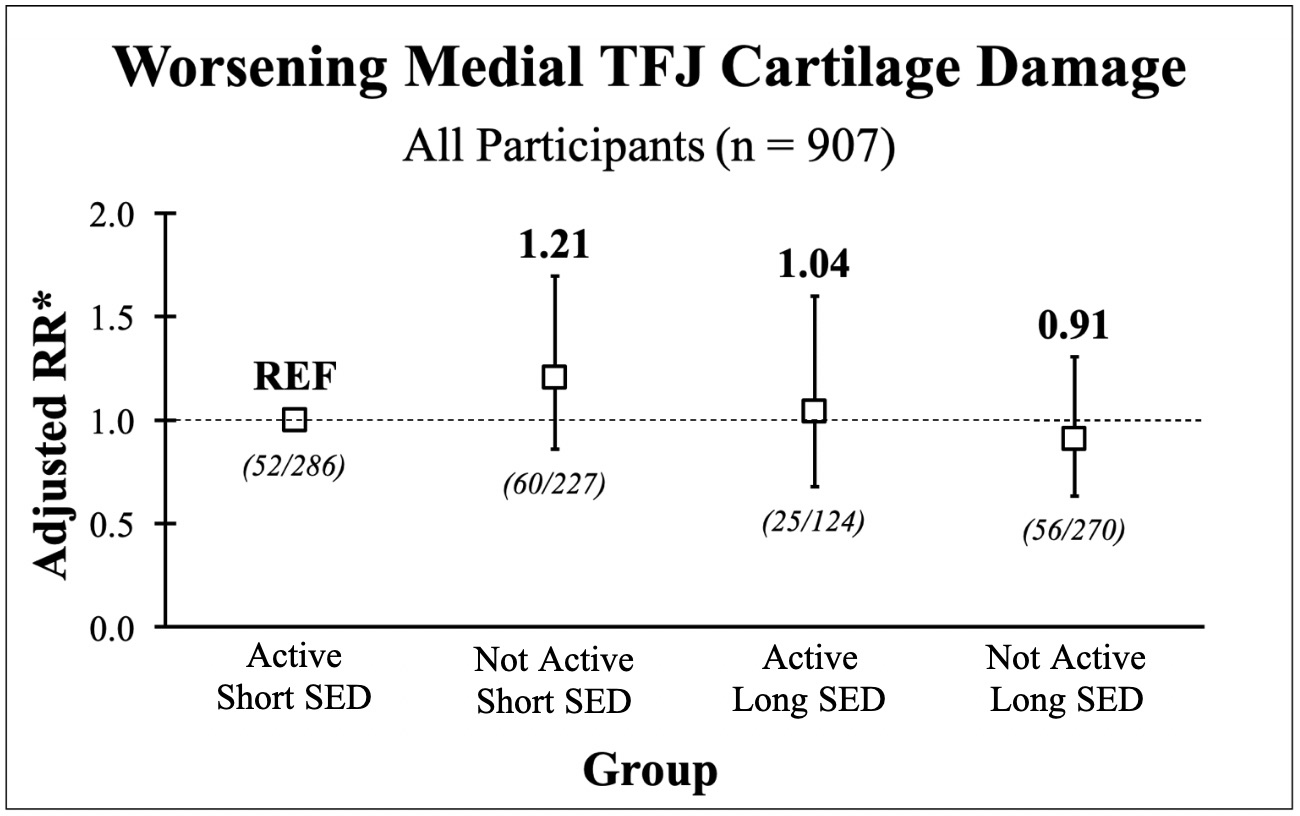Session Information
Date: Saturday, November 7, 2020
Title: Epidemiology & Public Health Poster II: OA, Osteoporosis, & Other Rheumatic Disease
Session Type: Poster Session B
Session Time: 9:00AM-11:00AM
Background/Purpose: Knee cartilage requires loading, e.g., walking, to remain healthy. When cartilage is deprived of loading, i.e., during bouts of sedentary time, it becomes vulnerable to damage. Thus, achieving more steps/day, and distributing steps throughout the day, may be important for cartilage health. However, the joint effects of walking and sedentary bouts on cartilage health are not known.
We conducted an exploratory analysis to examine the joint association of walking and sedentary bouts with worsening cartilage damage in the medial tibiofemoral joint (TFJ), a common site for knee osteoarthritis (OA), in adults with or at risk for knee OA. We also stratified our analysis by obesity status, as it may modify the above relationship.
Methods: We used data from the Multicenter Osteoarthritis (MOST) Study, a NIH-funded cohort study of adults with or at risk of knee OA. Participants had minute-by-minute accelerometry data collected via the StepWatch Activity Monitor (Orthocare Innovations) at baseline. We included participants with ≥4 days of ≥10 hours/day of wear. For each participant, we estimated average steps/day and typical sedentary bout length (SED, minutes); the latter was estimated using an established weighted median approach (Chastin, 2010). We dichotomized steps/day by the sample median: Active (≥9,300 steps/day) and Not Active (< 9,300 steps/day). We dichotomized typical sedentary bout length by the median: Short SED (< 30 min) or Long SED (≥30 min). This yielded four groups: 1) Active/Short SED (REF); 2) Not Active/Short SED; 3) Active/Long SED; 4) Not Active/Long SED.
Participants had knee MRIs (1.0T, OrthOne) at baseline and two years. Cartilage morphology was scored from 0-6 in 5 subregions of the medial TFJ using the Whole Organ Magnetic Resonance Imaging Score by two musculoskeletal radiologists. Our outcome, worsening medial TFJ cartilage damage over 2 years, was defined as an increased score in any medial TFJ subregion, including within-grade changes. We used binomial regression with robust variance estimation to calculate risk ratios (RR) and 95% confidence intervals (95% CI) for worsening damage in each group. Analyses were adjusted for age, sex, and body mass index (BMI). We also separately analyzed those who were non-obese (BMI < 30 kg/m2) vs. obese (BMI ≥ 30 kg/m2).
Results: We included 907 participants (66.7 years, 62% female, BMI: 29.7 kg/m2). Risk for worsening medial TFJ cartilage damage was not different between groups in the full sample or in non-obese participants (n=492). However, among obese participants (n=415), those in the Not Active/Short SED and Active/Long SED groups had 1.51 [0.92-2.48] and 1.77 [0.99-3.17] times the risk for worsening damage, respectively, compared with those in the Active/Short SED (REF) group, though neither reached statistical significance. Participants in the Not Active/Long SED group did not have greater risk (1.16 [0.70-1.93]) for worsening damage compared with the REF group.
Conclusion: For adults with or at risk for knee OA who are obese, either lower steps/day or longer typical sedentary bout length may be related to worsening medial TFJ cartilage damage; however, the combination of fewer steps/day and longer sedentary time was not related to worsening damage.
 Figure 1. RR and 95%CI (represented by error bars) for worsening medial TFJ cartilage damage in all participants. *Analyses were adjusted for age, sex, and BMI.
Figure 1. RR and 95%CI (represented by error bars) for worsening medial TFJ cartilage damage in all participants. *Analyses were adjusted for age, sex, and BMI.
 Figure 2. RR and 95%CI (represented by error bars) for worsening medial TFJ cartilage damage in participants who are non-obese. *Analyses were adjusted for age, sex, and BMI.
Figure 2. RR and 95%CI (represented by error bars) for worsening medial TFJ cartilage damage in participants who are non-obese. *Analyses were adjusted for age, sex, and BMI.
 Figure 3. RR and 95%CI (represented by error bars) for worsening medial TFJ cartilage damage in participants who are obese. *Analyses were adjusted for age, sex, and BMI.
Figure 3. RR and 95%CI (represented by error bars) for worsening medial TFJ cartilage damage in participants who are obese. *Analyses were adjusted for age, sex, and BMI.
To cite this abstract in AMA style:
Voinier D, Neogi T, Stefanik J, Guermazi A, Roemer F, Master H, Thoma L, Christiansen M, Jakiela J, Nevitt M, Lewis C, Torner J, White D. The Joint Association of Steps/day and Typical Sedentary Bout Length with Worsening Knee Cartilage Damage over Two Years: The MOST Study [abstract]. Arthritis Rheumatol. 2020; 72 (suppl 10). https://acrabstracts.org/abstract/the-joint-association-of-steps-day-and-typical-sedentary-bout-length-with-worsening-knee-cartilage-damage-over-two-years-the-most-study/. Accessed .« Back to ACR Convergence 2020
ACR Meeting Abstracts - https://acrabstracts.org/abstract/the-joint-association-of-steps-day-and-typical-sedentary-bout-length-with-worsening-knee-cartilage-damage-over-two-years-the-most-study/
